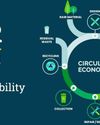Don't Get Bamboozled by Bamboo…. There are more Sustainable Alternatives
Textile Value Chain
|October 2020
Bamboo fabric has been paraded as one of the Sustainable alternatives to ‘resource guzzling’ cotton or polyester - a ‘polluting’ petrochemical derivative. With fame came detractors, and soon we were made to realize that Bamboo fibre production process was indeed ‘unsustainable’.

Growing of bamboo grass was pro-nature with incredible set of benefits like lower requirement of water, fertilizer, or pesticides, and sequesters a large amount of carbon dioxide, absorbing five times more carbon dioxide and releasing 35% more oxygen than similar plants. It’s also naturally regenerating, so harvesting bamboo still allows the plant to survive. However, the truth is that the process of converting this fibre present in bamboo stalks to fabric is ‘chemically toxic’ for our environment. The process involves dissolving the harvested bamboo stalks using strong chemical solvents like sodium hydroxide and carbon disulfide. This process is also known as hydrolysis alkalization which is combined with multi-phase bleaching.
In most of the factories, the revival of solvent is 50%. This means the other 50% is discarded into the environment. The production processes for bamboo and other regenerated fibres using hydrolysis alkalization is not considered sustainable or environment friendly because it poses severe health risks and pollutes the surrounding environment. This process is similar to the production of Rayon from wood chips and plant-based materials, and should be ideally called bamboo-rayon with no residual natural properties of bamboo.
The ideal ‘sustainable bamboo fibre’ can be achieved only through a mechanical extraction process that involves combing out the fibres and spinning these into threads, which is then called bamboo linen. This is labour-intensive and offers low production output. Given these inefficiencies, the cheaper alternative is the chemical-intensive alternative.
Diese Geschichte stammt aus der October 2020-Ausgabe von Textile Value Chain.
Abonnieren Sie Magzter GOLD, um auf Tausende kuratierter Premium-Geschichten und über 9.000 Zeitschriften und Zeitungen zuzugreifen.
Sie sind bereits Abonnent? Anmelden
WEITERE GESCHICHTEN VON Textile Value Chain

Textile Value Chain
EPR in Textiles: Turning Compliance into Opportunity
When the EU Comes to Panipat, It Means One Thing — The World Is Watching
3 mins
November 2025

Textile Value Chain
European Parliament Delegation Visits Panipat Recycling Cluster to Strengthen India-EU Collaboration on Circular Textiles
A high-level delegation from the European Parliament's Committee on International Trade (INTA) visited the Panipat Textile Recycling Cluster — India's largest hub for recycled textiles and circular manufacturing — during their official visit to India.
1 mins
November 2025

Textile Value Chain
Paramount Instruments: Where Innovation Turns Testing into Joy
At Paramount Instruments, innovation isn't just a Pursuit- it's in our DNA.
2 mins
November 2025
Textile Value Chain
Crafting the Future: LMW & Hami Weavelon pioneer Compact Spinning in Polyester
Manmade fibres today form the backbone of the global textile industry, driven by their versatility, performance, and ability to meet the rising demand for both everyday and specialised applications.
3 mins
November 2025

Textile Value Chain
Data is the New Thread: Weaving India's Textile Sector into a Circular Powerhouse
On November 13, 2025, at the 12th Edition of the India and Sustainability Standards (ISS) International Dialogue and Conference held at Bharat Mandapam in New Delhi, representatives from the Home Exporters Welfare Association of India (HEWA) joined industry leaders, policymakers, and international organizations to address a pressing question: How can India's textile sector meet emerging global data requirements while supporting its MSME backbone?
3 mins
November 2025

Textile Value Chain
Rieter Winding Suction Nozzle Upgrade: More Yarn, Less Energy Use
After upgrading the suction nozzles on their 32 winding machines, Sanyang Textile Co., Ltd., China, saw an increase in yarn production of 3% and a reduction of 13% in energy use. The flow-optimised, aerodynamically designed suction nozzle enables efficient upper yarn search and pickup from the package. This results in a 55% reduction in red light percentage and a significant reduction in the operator's workload.
1 mins
November 2025

Textile Value Chain
EU's Extended Producer Responsibility (EPR) Law and Its Implications for India's Textile Industry
The European Union (EU) has approved a new Extended Producer Responsibility (EPR) framework for textiles. This is a major regulatory shift that makes fashion brands and producers accountable for their products' entire lifecycle, from design and production through collection, sorting, recycling and disposal.
9 mins
November 2025

Textile Value Chain
GTE Ahmedabad 2025 Concludes Day 3 with a Huge Footfall
The 38th Garment Technology Expo (GTE) Ahmedabad 2025, co-located with the Lace & Trims Show, wrapped up its third day on an impressive note, recording around 9,700 B2B visitors. The strong industry turnout reaffirmed the expo's role as one of the most influential and business-driven platforms for garment and apparel technology in the western region.
2 mins
November 2025

Textile Value Chain
Reinterpreting Korean Street Fashion through Sustainable Design Practices
A Path through Eco-conscious Urban Fashion
7 mins
November 2025

Textile Value Chain
3D Printing in Textiles Manufacturing: A Game-Changer in Design, Sustainability, and Efficiency
The global textile and apparel industry is undergoing a radical transformation due to the convergence of digital design, advanced material technology, and next-generation manufacturing. Of the latter, few have greater potential to change how textiles are made today than additive manufacturing, better known as 3D printing.
5 mins
November 2025
Translate
Change font size

